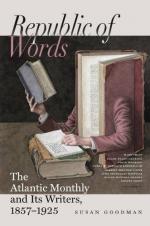“There are two sunny windows to begin with,” says the good fairy, with an appreciative glance. “That insures flowers all winter.”
“Yes,” says John; “I never would look at a house without a good sunny exposure. Sunshine is the best ornament of a house, and worth an extra thousand a year.
“Now for our wall-paper,” says she. “Have you looked at wall-papers, John?”
“Yes; we shall get very pretty ones for thirty-seven cents a roll; all you want of a paper, you know, is to make a ground-tint to throw out your pictures and other matters, and to reflect a pleasant tone of light.”
“Well, John, you know Uncle James says that a stone-color is the best,—but I can’t bear those cold blue grays.”
“Nor I,” says John. “If we must have gray, let it at least be a gray suffused with gold or rose-color, such as you see at evening in the clouds.”
“So I think,” responds she; “but better, I should like a paper with a tone of buff,—something that produces warm yellowish reflections, and will almost make you think the sun is shining in cold gray weather; and then there is nothing that lights up so cheerfully in the evening. In short, John, I think the color of a zafferano rose will be just about the shade we want.”
“Well, I can find that, in good American paper, as I said before, at from thirty-seven to forty cents a roll. Then, our bordering: there’s an important question, for that must determine the carpet, the chairs, and everything else. Now what shall be the ground-tint of our rooms?”
“There are only two to choose between,” says the lady,—“green and maroon: which is the best for the picture?”
“I think,” says John, looking above the mantel-piece, as if he saw a picture there,—“I think a border of maroon velvet, with maroon furniture, is the best for the picture.”
“I think so too,” said she; “and then we will have that lovely maroon and crimson carpet that I saw at Lowe’s;—it is an ingrain, to be sure, but has a Brussels pattern, a mossy, mixed figure, of different shades of crimson; it has a good warm, strong color, and when I come to cover the lounges and our two old arm-chairs with a pretty maroon rep, it will make such a pretty effect.”
“Yes,” said John; “and then, you know, our picture is so bright, it will light up the whole. Everything depends on the picture.”
Now as to “the picture,” it has a story must be told. John, having been all his life a worshipper and adorer of beauty and beautiful things, had never passed to or from his business without stopping at the print-shop windows, and seeing a little of what was there.
On one of these occasions he was smitten to the heart with the beauty of an autumn landscape, where the red maples and sumachs, the purple and crimson oaks, all stood swathed and harmonized together in the hazy Indian-summer atmosphere. There was a great yellow chestnut-tree, on a distant hill, which stood out so naturally that John instinctively felt his fingers tingling for a basket, and his heels alive with a desire to bound over on to the rustling hill-side and pick up the glossy brown nuts. Everything was there of autumn, even to the golden-rod and purple asters and scarlet creepers in the foreground.




